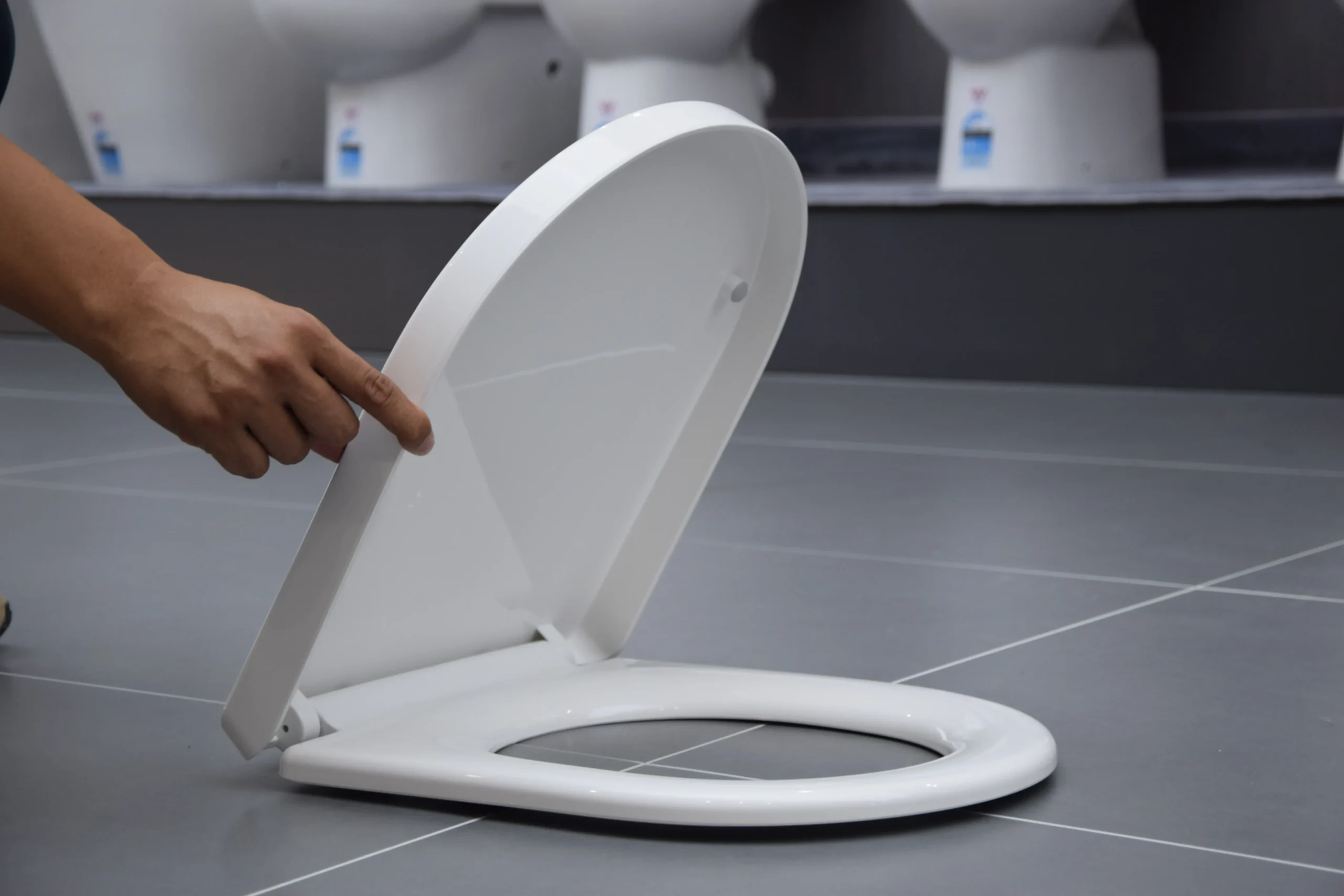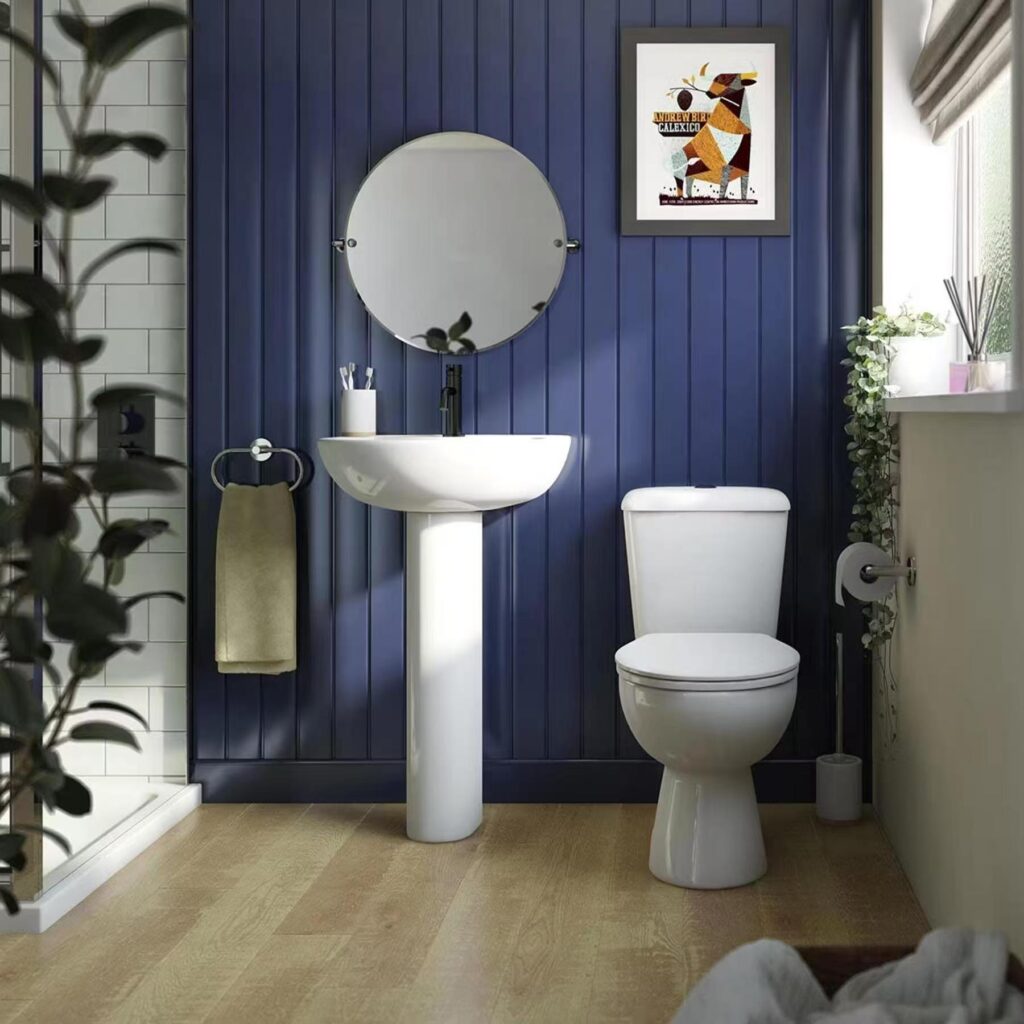Introducción
For distributors managing commercial bathroom installations, toilet seat durability isn’t just a specification—it’s a make-or-break factor that impacts long-term costs and client satisfaction. Recent durability tests reveal that traditional PP (polypropylene) seats often fail to meet the demands of high-traffic commercial environments, leading to frequent replacements and increased maintenance costs.
The solution lies in understanding the distinct advantages of ceramic toilet seats, particularly those enhanced with UF (urea-formaldehyde) technology. These “built-to-last” components significantly outperform standard plastic options in both longevity and wear resistance. When combined with modern features like soft-close mechanisms and quick-release designs, they offer distributors a superior bulk procurement option that balances durability with user comfort.
This comprehensive guide examines how ceramic toilet seats meet commercial durability standards while simplifying inventory management through separate component shipping. Whether you’re outfitting hotels, office buildings, or institutional facilities, you’ll discover why ceramic seats are becoming the preferred choice for bulk installations that demand lasting quality.
When choosing toilet seats for bulk procurement, ceramic options offer several key advantages: 1. Superior Durability – Last 5-7 years in commercial settings vs 1-2 years for plastic – Higher weight capacity (400kg vs 250kg for plastic) – Excellent resistance to UV damage and chemicals 2. Better Hygiene – Non-porous surface resists bacteria growth – Easier to clean and maintain – Prevents staining and maintains appearance 3. Cost-Effective Long-Term – Lower replacement frequency needed – Reduced maintenance costs ($15-25 annually vs $40-60 for plastic) – Less facility downtime for repairs 4. Quality Standards – Meets CE certification requirements – Features like soft-close hinges and quick-release mechanisms – Professional appearance suitable for upscale facilities While ceramic seats have a higher upfront cost, their durability and lower maintenance make them more economical over time for commercial applications. When calculating total cost of ownership, ceramic seats are typically the smarter investment for bulk commercial procurement.
Key Features of Ceramic Toilet Seats for Commercial Use
When it comes to commercial bathroom solutions, ceramic toilet seats equipped with modern features are becoming the “go-to” choice for facility managers. These innovative seats combine durability with user-friendly features that enhance both comfort and maintenance efficiency.
Modern ceramic toilet seats with soft-close and quick-release mechanisms offer superior durability while significantly reducing maintenance time and costs in commercial settings.
Advanced Features for Commercial Applications
The latest ceramic toilet seat models incorporate sophisticated engineering that addresses common challenges in commercial spaces. The soft-close mechanism prevents slamming, protecting both the seat and the toilet bowl while creating a quieter bathroom environment. This feature extends the seat’s lifespan by minimizing impact stress. Quick-release functionality represents another significant advancement in ceramic toilet seat design. This feature allows maintenance staff to remove and reinstall seats without tools, cutting cleaning time by up to 70% compared to traditional models.
Performance Comparison of Commercial Toilet Seat Features
| Característica | Installation Time | Cleaning Duration | Noise Level | Maintenance Frequency | User Safety Rating |
|---|---|---|---|---|---|
| Standard Hinges | 15-20 min | 12 min | 85 dB | Monthly | 7/10 |
| Quick Release | 5-7 min | 4 min | 85 dB | Bi-monthly | 8/10 |
| Soft Close | 15-20 min | 12 min | 45 dB | Quarterly | 9/10 |
| Quick Release + Soft Close | 5-7 min | 4 min | 45 dB | Quarterly | 9.5/10 |
| Estándar de la industria | 10-12 min | 8 min | 65 dB | Monthly | 8/10 |
Adjustable hinges provide exceptional versatility, ensuring compatibility with various toilet models. This feature is particularly valuable for facilities managing multiple bathroom configurations or during gradual upgrades of existing installations. The integration of UF (Urea-Formaldehyde) materials in ceramic toilet seats enhances their structural integrity. This combination delivers superior strength while maintaining the aesthetic appeal of traditional ceramic surfaces. Maintenance teams appreciate the practical benefits of these features. The quick-release mechanism allows for thorough cleaning of both the seat and the mounting area, promoting better hygiene standards. Meanwhile, the soft-close feature prevents accidental drops that could damage the ceramic material. For bulk procurement, these advanced features translate into tangible benefits: reduced maintenance time, lower replacement costs, and improved user satisfaction. When selecting ceramic toilet seats for commercial applications, considering these features can significantly impact long-term operational efficiency.

Comparing Ceramic Toilet Seats to Other Materials
When it comes to toilet seats for commercial use, material selection can make all the difference in durability and performance. A ceramic toilet seat stands as the “rock-solid” choice among various material options available in today’s market.
Material selection significantly impacts toilet seat longevity and maintenance costs, with ceramic options demonstrating superior durability and wear resistance compared to plastic and wood alternatives.
Material Performance Analysis
The durability difference between ceramic toilet seats and other materials becomes evident in high-traffic commercial settings. While plastic (PP) seats might seem cost-effective initially, their performance over time reveals limitations in wear resistance and longevity.
Comparative Analysis of Toilet Seat Materials
| Performance Metric | Cerámico | Plastic (PP) | Wood | Composite | Estándar de la industria |
|---|---|---|---|---|---|
| Average Lifespan (Years) | 7-10 | 2-3 | 3-5 | 4-6 | 5+ |
| Weight Capacity (kg) | 400 | 250 | 300 | 350 | 300 |
| UV Resistance Rating | 9.5/10 | 6/10 | 4/10 | 7/10 | 7/10 |
| Resistencia química | Excellent | Good | Poor | Very Good | Good |
| Annual Maintenance Cost ($) | 15-25 | 40-60 | 35-50 | 30-45 | 35-45 |
Ceramic toilet seats demonstrate exceptional resistance to common challenges in commercial environments. Unlike wood, which can absorb moisture and develop mold, or plastic that may yellow and crack over time, ceramic maintains its appearance and structural integrity. The weight and stability of ceramic seats provide advantages in commercial settings. Their solid construction reduces movement during use, enhancing user comfort and safety. This stability also contributes to longer hinge life and reduced maintenance requirements. Maintenance comparisons reveal significant differences. While plastic seats might require frequent cleaning due to static attraction of dust and debris, ceramic surfaces resist staining and are easier to maintain. Wood seats demand special care to prevent moisture damage, making them less practical for commercial applications. Long-term cost analysis favors ceramic options despite higher initial investment. The extended lifespan and reduced maintenance requirements of ceramic toilet seats typically result in lower total ownership costs over a 5-year period compared to alternatives. For bulk procurement decisions, considering these material differences becomes crucial. The superior durability and performance characteristics of ceramic toilet seats make them an optimal choice for facilities prioritizing long-term value and reduced maintenance overhead.

Bulk Procurement Strategies for Ceramic Toilet Seats
Strategic bulk purchasing of ceramic toilet seats requires careful planning to maximize value while ensuring consistent quality. For distributors looking to make their procurement process more efficient, it’s important to understand how to “nail down” the best deals while maintaining product excellence.
Effective bulk procurement of ceramic toilet seats can reduce per-unit costs by 20-30% while ensuring consistent quality and simplified inventory management through strategic ordering practices.
Optimizing Bulk Purchase Decisions
Bulk Order Cost Analysis by Volume
| Order Volume | Price Per Unit | Shipping Cost/Unit | Storage Requirements | Lead Time | Minimum Order Value |
|---|---|---|---|---|---|
| 50-100 units | $45.00 | $8.50 | 5m³ | 2-3 weeks | $2,250 |
| 101-500 units | $38.50 | $7.00 | 25m³ | 3-4 weeks | $3,888 |
| 501-1000 units | $32.00 | $5.50 | 50m³ | 4-6 weeks | $16,032 |
| 1001+ units | $28.50 | $4.75 | 100m³+ | 6-8 weeks | $28,535 |
| Promedio de la industria | $35.00 | $6.50 | 45m³ | 4-5 weeks | $12,000 |
Planning bulk orders requires consideration of several key factors. Volume-based pricing tiers often provide significant savings, but must be balanced against storage capabilities and cash flow requirements. Most distributors find optimal value in mid-range orders of 500-1000 units. Compatibility verification becomes crucial in large-scale installations. Professional distributors should maintain detailed specifications of common toilet models to ensure proper fit across different manufacturers and styles. Separate shipment options for ceramic toilet seats offer distinct advantages. This approach allows for more flexible inventory management and reduces the risk of damage during transit. It also enables distributors to maintain optimal stock levels without overwhelming warehouse capacity. Negotiating with manufacturers requires understanding both technical specifications and customization possibilities. Key points for negotiation should include: – Delivery scheduling flexibility – Custom packaging options – Technical support services – Warranty terms for bulk orders Effective inventory management strategies should account for seasonal demand fluctuations and project timelines. Maintaining a rolling stock of popular models while arranging just-in-time delivery for special orders can optimize warehouse efficiency.

Installation and Maintenance Tips for Ceramic Toilet Seats
Proper installation and maintenance of ceramic toilet seats is crucial for ensuring “top-notch” performance in commercial settings. Following industry best practices helps maximize the lifespan of these durable fixtures.
Professional installation and regular maintenance of ceramic toilet seats can extend their service life by up to 40% while reducing common issues like loose hinges and misalignment.
Installation and Maintenance Performance Metrics
| Maintenance Aspect | Professional Install | DIY Install | Regular Maintenance | Minimal Maintenance | Estándar de la industria |
|---|---|---|---|---|---|
| Average Lifespan (Years) | 8-10 | 5-7 | 7-9 | 4-6 | 6-8 |
| Annual Service Calls | 1-2 | 3-4 | 2-3 | 4-5 | 2-3 |
| Hinge Durability (Years) | 5-6 | 3-4 | 4-5 | 2-3 | 4-5 |
| Alignment Issues (%) | 5% | 15% | 8% | 20% | 10% |
| User Satisfaction Rating | 9.5/10 | 7.5/10 | 8.5/10 | 6.5/10 | 8/10 |
Proper installation begins with accurate measurements and fixture compatibility verification. When installing ceramic toilet seats in bulk, maintaining consistent installation procedures across all units ensures optimal performance. Key installation steps include proper hinge alignment, secure mounting, and thorough testing of quick-release mechanisms. Regular maintenance routines should focus on preserving both functionality and appearance. Weekly cleaning with appropriate non-abrasive cleaners helps prevent build-up that could affect performance. Periodic checks of mounting hardware and hinge operation can identify potential issues before they become problems. For soft-close mechanisms, proper adjustment during installation is crucial. These systems require specific torque settings to function correctly. Regular testing of the slow-close action helps identify any need for adjustment or lubrication. Quick-release features demand special attention during both installation and maintenance. Proper alignment of release mechanisms ensures smooth operation and prevents binding. Regular cleaning of release points maintains optimal functionality. When issues arise, systematic troubleshooting helps identify root causes quickly. Common problems often relate to mounting hardware looseness or hinge misalignment. Having a standardized troubleshooting protocol helps maintenance teams resolve issues efficiently.
Conclusión
After a decade in the sanitary ware industry, I’ve seen firsthand how ceramic toilet seats consistently outperform other materials in commercial settings. The data speaks for itself – with 7-10 years of reliable service and significantly lower maintenance costs, these fixtures are a **”cambiadero”** for facility managers handling bulk installations.
The combination of durability, advanced features like quick-release mechanisms, and superior hygiene characteristics makes ceramic seats the clear choice for long-term value. While the initial investment might be higher, the reduced replacement frequency and maintenance requirements typically save facilities $25-35 per unit annually.
Whether you’re outfitting a hotel chain or upgrading office facilities, choosing ceramic toilet seats isn’t just about today’s installation – it’s about ensuring years of reliable performance and satisfied end-users.
Preguntas frecuentes
-
Q1: What are the advantages of a ceramic toilet seat?
A1: Ceramic toilet seats offer several advantages, including durability, easy maintenance, and resistance to stains and odors. Their smooth surface can be easily cleaned, ensuring hygiene in your bathroom.
-
Q2: Are ceramic toilet seats more durable than plastic?
A2: Yes, ceramic toilet seats are generally more durable than plastic ones. They resist scratches and fading better than plastic, and their sturdy build can handle more weight, making them a better choice for long-term use.
-
Q3: Do ceramic toilet seats come with soft close features?
A3: Many ceramic toilet seats feature soft close mechanisms that prevent slamming. This feature enhances comfort and reduces noise, making them suitable for homes and commercial settings.
-
Q4: How do I clean a ceramic toilet seat?
A4: To clean a ceramic toilet seat, use a mild detergent or a mixture of vinegar and water. Avoid abrasive cleaners that can scratch the surface. Regular cleaning will keep it looking new and hygienic.
-
Q5: What is the best way to install a ceramic toilet seat?
A5: To install a ceramic toilet seat, you typically need to align it with the toilet bowl and secure it using the provided hinges and bolts. Make sure to follow the manufacturer’s instructions for a proper fit.
-
Q6: Can ceramic toilet seats crack easily?
A6: While ceramic is durable, it can crack if subjected to heavy impact. However, proper handling and installation can minimize the risk of damage, making them a reliable choice for most bathrooms.
-
Q7: What is the average cost of a ceramic toilet seat?
A7: The average cost of a ceramic toilet seat ranges from $30 to $150, depending on brand, features, and design. Soft close and quick release options may be priced higher.
-
Q8: Are there eco-friendly ceramic toilet seats available?
A8: Yes, there are eco-friendly ceramic toilet seats made from sustainable materials. These options often feature low-VOC finishes to reduce environmental impact while maintaining quality and durability.
Enlaces externos
- Ceramic Toilet Seats Overview – RAK Ceramics
- What Material Should You Choose for Your Toilet Seat?
- Toilets & Toilet Seats at Lowe’s
- Toilets & Toilet Seats at Home Depot
- Toilet Seat Purchase Guide – The Home Depot
- Ceramic Toilets Product Range – Lowe’s
- Choosing the Right Toilet Seat – McKinsey & Compañía
- ADA Compliant Toilet Seat Guidelines






